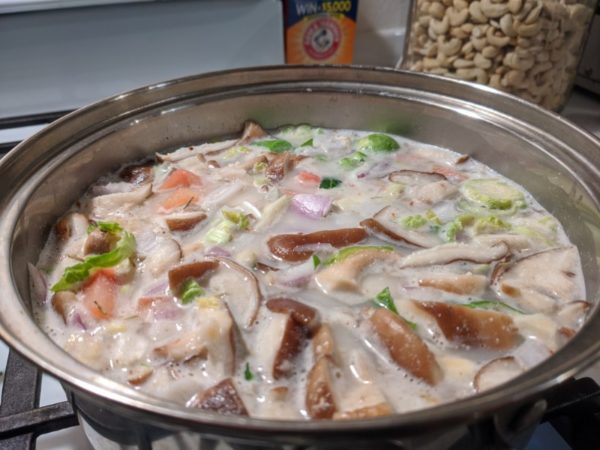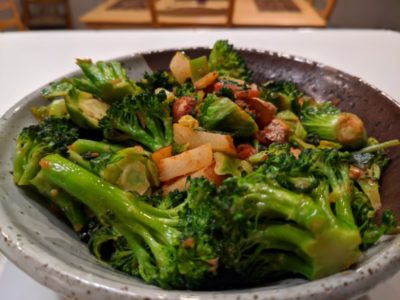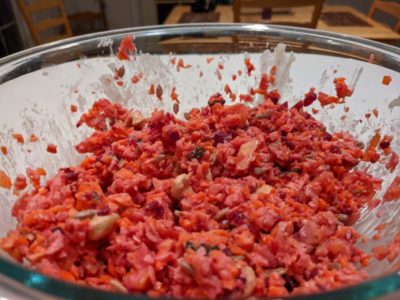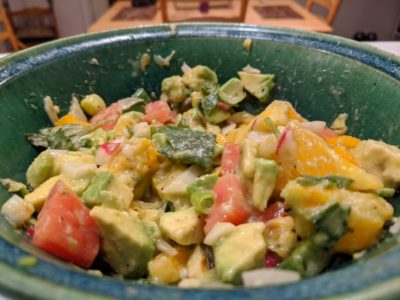
Most people know me as an Iraqi Jew. So they would corner me at the local synagogue, asking – in a tone that was part-conspiring and part-patronizing (because food was all Iraqi Jews were good for) – what I ate for dinner growing up. “Stouffers,” I’d reply, simultaneously disappointing and confusing them. What they didn’t know was that while my father hailed straight out of Baghdad, my mother was a Jew by choice, from a Danish-Welsh-Irish Christian background, and that while she was a brilliant artist, it was not in the kitchen (“because I had to do it,” she explained). She not only burned the aforementioned Stouffers, but also Minute Rice, whose tagline was something along the lines of how it could not, under any circumstances, be burned. Minute Rice, meet my mother.
In addition, my family was the kind that bought half a gallon of ice cream and polished it off in 10 minutes flat, so that when I was at a friend’s house and encountered half a pint of ice cream with freezer burn, because it had been sitting there so long, my brain did not know how to process what I was seeing.
Which all goes to say, I was on my own when I made the decision to get healthy in my eating. It was back in 1992, shortly after graduating college – where my nutritional intake consisted primarily of Entenmann’s pastries and Ben & Jerry’s ice cream. Artistic and uninterested in being told what to do, just like my mother, I just started throwing healthy things into pots and bowls and seeing what happened. In the early days, my food tasted awful about half the time, with overpowering spices, weird food combinations, and – also following in my mother’s footsteps – dishes that set off the fire alarm.
As I continued experimenting, however, I developed a sense of what works and what doesn’t. And for decades now, I have been a bona fide gourmet cook, with people loving everything I make. The thing is, when they ask what I put in there, I’m fuzzy on the details. I’m a combination of mad scientist and inspired artist in the kitchen – living in the moment, allowing the colors and tastes and textures to call out to me and tell me what to do with them. My mom, come to think of it, told me that’s how she made art: She would buy all kinds of materials and let them sit around and “talk to [her].” Meaning, in this family, we do what the voices tell us to do.
The thing is, it’s a fun, creative, passionate, and exciting way to cook. I don’t entirely shun recipes, mind you – I have a collection of all kinds of cook books from all over the world, with all sorts of pretty pictures, which I flip through. Occasionally I even incorporate parts of those recipes, to help me get out of the rut of my own mindset and shake up my culinary thinking. But mostly, I follow a few basic principles for a whole foods, plant-based diet, which I’m now happy to share with you:

1. Buy nutrient dense foods.
Maybe you’re vegan, maybe you’re not. Either way, make sure that the overwhelming majority of your food intake is produce, ideally organic. And if you eat animal products, be ethical about it – getting pasture-raised products, also ideally organic.
2. Eat fresh.
Use primarily fresh vegetables and fruits, ideally from a farmer’s market, for optimal flavor and nutrients.
3. Get creative.
Go after a diverse array of colors, textures, and flavors. Keep your mouth interested and surprised throughout the eating experience. For example, here are some things to throw into a salad:
COLORS: Combine green (lettuce), red (tomatoes), white (turnips), and purple (“red” onions)
TEXTURES: Combine crunchy (celery), chewy (raisins), flaky (nutritional yeast), and mushy (warm quinoa).
TASTES: Combine spicy (radish), tangy (olives), sweet (apples), and salty (nuts)
4. Keep it simple.
Wherever possible, buy pre-washed produce and/or hire someone to wash all you produce for you ahead of time, so that you just need to chop things up and throw them into a pot or bowl.
5. Use healthy fats.
For raw foods, use olive oil, sesame oil, or flax oil, and for cooked foods, use avocado oil, coconut oil, or ghee – again, organic is preferable.
6. Mix it up.

Use different ingredient combinations and ratios, to keep things interesting. A salad can be unique and surprising, every single time you make it!
7. Spice it up.
Figure out what spices appeal to you, and experiment with them. Err on the side of caution, using less instead of more, as
you learn how much is enough and how much is too much. Think in terms of “a hint of” and “a dash of,” so that you don’t overpower a dish with one or more spices.
Also use different combinations, to keep your dishes tasting entirely unique.
8. Pick a centerpiece
Randomly decide what vegetable or fruit will dominate the dish – for example, a carrot salad versus a greens salad – and use more of the dominant flavor and less of the other flavors, which you can think of as the backup singers to the lead vocalist. Instead of using an entire carrot for each dish you create, use a few slices here and a lot of slices there.
9. Diversify the look.
Slice horizontally, vertically, or diagonally; cut into cubes; shred in a food processor; or find some other interesting way to present each vegetable or fruit. Mix it up, so that there is a whole lot of fun going on in your dish.

10. Serve with flair.
Buy artsy bowls and plates, to present your food with
beauty and increase how appetizing it is to you. Light some candles, put on some relaxing music, and enjoy your self-nourishing meal.

